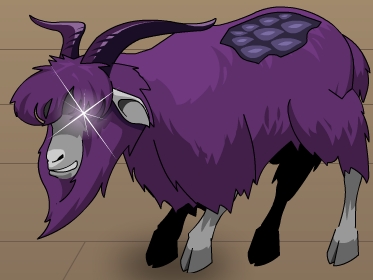F Is for Fearful
fearful: (adj.) feeling afraid; showing fear or anxiety
Nota Bene: Saturday, I posted a mutant monster for 1st edition Gamma World. Today’s monster fits Chaosium’s Basic Roleplaying, specifically the iteration found in the 4th edition of Stormbringer. Inspiration for this creature came from a conversation with my son Christopher about what fainting goats might evolve into in the far future.
Balo, Jester of Chaos, does not make himself felt in the Young Kingdoms with the same force as, say, Arioch, Pyaray, or Chardhros, but that doesn’t mean Balo’s peculiar sense of humor leaves the world untouched. Case in point: Balo’s goats, which are most often encountered in Argimiliarian outlands.
These magical animals appear very much like ordinary goats, except for their purple fur and that curious shine to their eyes. Like normal goats, Balo’s goats are largely inoffensive herbivores. When threatened, they prefer to run away. Of course, since that’s not very funny, Balo has blessed his goats with an unusual power that manifests when these beasts panic.

When a Balo’s goat panics, it emanates a 20-foot radius aura that affects non-Balo’s goat creatures. Compare the goat’s and the victim’s POW attributes. For every point the goat’s POW is higher than the victim’s, add 5% to the base 50% that the victim will be affected. For every point the goat’s POW is lower than the victim’s, subtract 5% from the base 50% that the victim will be affected. If affected, the victim’s extremities become paralyzed for 3d10 combat rounds. During this time, Balo’s goats tend to run away, leaving the paralyzed to whatever fate may be lurking nearby.
Balo’s Goats
Attributes
STR 2d6
CON 2d6+3
SIZ 2d6
INT 1d6
POW 3d6+7
DEX 2d6
Hit Points CON
Skills
Dodge 20% + 1d10
Panic 80% + 1d10
See 50% + 1d10
Scent 25% + 1d10
Weapon (Attack | Damage)
Butt (20% + 1d6 | 1d4)





